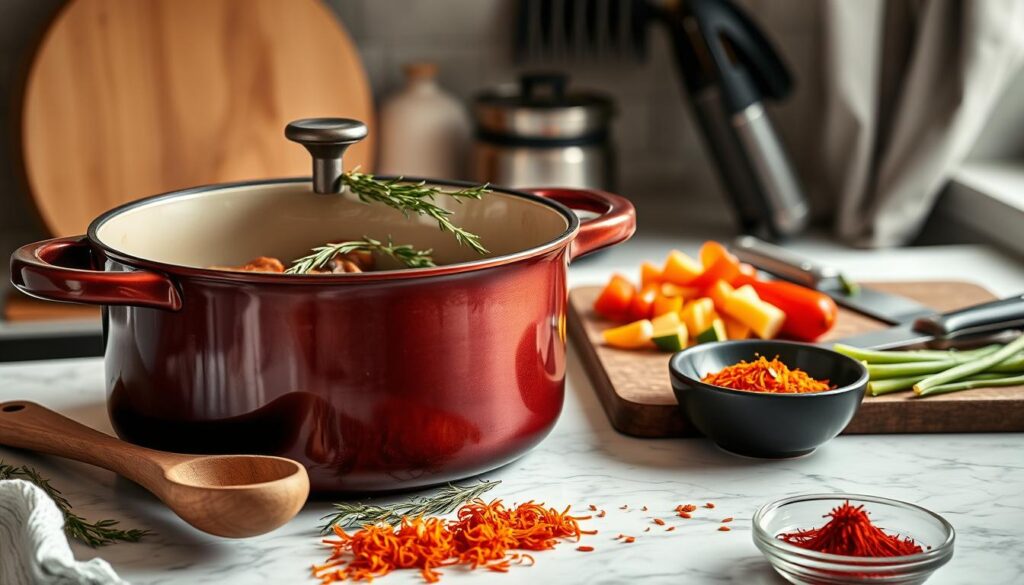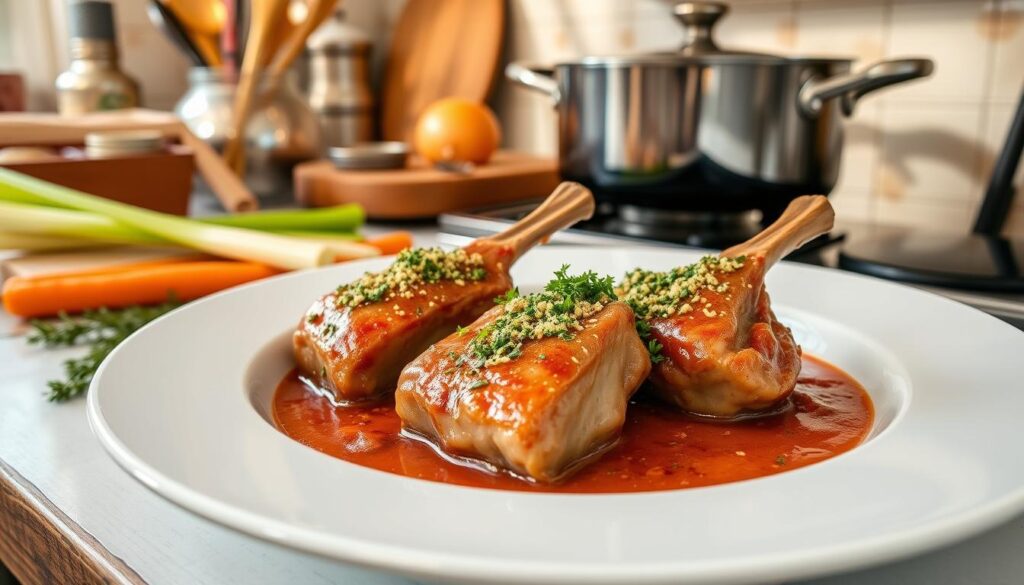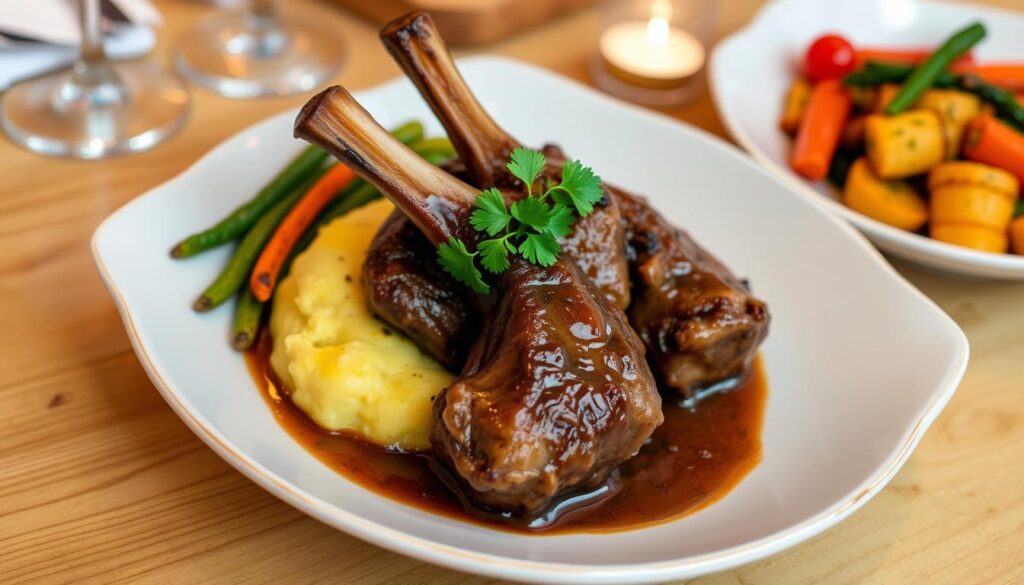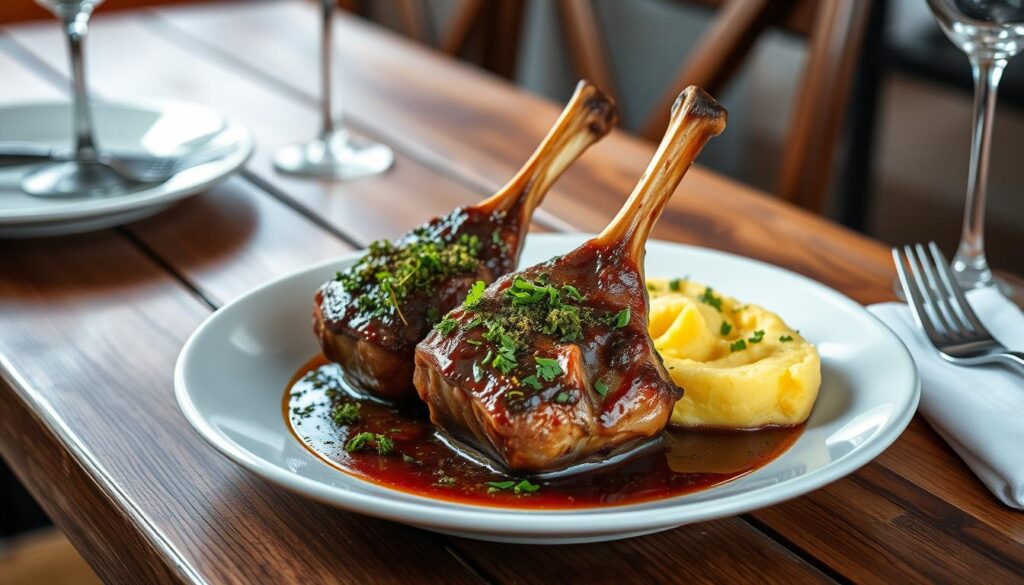When veal shanks simmer, I’m back in my grandmother’s kitchen in Milan. Osso buco’s rich flavors have been in our family for years. I’m thrilled to share this classic recipe with you.
I loved watching my grandmother make this dish. She was so careful with every ingredient. The veal, veggies, and sauce all came together beautifully.
Now, I’m happy to share this recipe with you. I hope you’ll enjoy the same warmth and comfort it brings to me.
Table of Contents
Understanding Traditional Italian Osso Buco
The bucco osso recipe comes from Milan, Italy. It’s a key dish in Milanese cuisine. It shows the area’s rich food history.
Origins of Milan’s Signature Dish
The osso buco story starts in the 18th century. It was made by Milanese cooks who were creative with veal shanks. They slow-cooked it with herbs and spices, making it a masterpiece.
What Makes Authentic Osso Buco Special
- The use of high-quality veal shanks, with their distinctive cross-section revealing the succulent bone marrow
- A long, slow braise that allows the flavors to meld and the meat to become fall-off-the-bone tender
- The addition of gremolata, a vibrant garnish of chopped parsley, garlic, and lemon zest, which brightens the dish
The Importance of Marrow in Italian Cuisine
In bucco osso, the bone marrow is a treasure. Its creamy texture and deep flavor make the dish special. This shows Italy’s respect for using all parts of the animal.
Essential Ingredients for Perfect Osso Buco
Making a delicious osso buco dish needs careful picking of top-notch ingredients. At its core, the veal shanks are key. They should be fresh, tender, and well-marbled for the best taste and texture. Alongside, a mix of aromatic veggies, herbs, and white wine create the rich, savory sauce that makes osso-buco special.
To make the perfect osso-buco, you’ll need these key ingredients:
- Veal shanks – Choose 2-3 inch thick cuts for the best results.
- Onions – Diced or thinly sliced.
- Carrots – Peeled and cut into 1-inch pieces.
- Celery – Chopped into bite-sized pieces.
- Herbs – Fresh or dried sprigs of rosemary, thyme, and parsley.
- White wine – Dry, full-bodied varieties like Pinot Grigio or Chardonnay work beautifully.
- Tomato paste – For added depth of flavor.
- Beef or chicken stock – To create the rich, velvety sauce.
- Butter and olive oil – For searing and sautéing.
- Salt and pepper – To season the dish to perfection.
With these osso buco ingredients ready, you’re set to make a truly remarkable Italian classic. It will delight your senses and leave you wanting more.
“The secret to a great osso-buco lies in the quality of the veal shanks and the care taken in cooking them to perfection.”
Selecting the Best Veal Shanks for Your Dish
Choosing the right veal shanks is key for perfect osso-buco. The meat’s quality affects the dish’s flavor, texture, and success. As a seasoned home cook, I’ve found some essential tips for picking the best veal shanks for your Italian feast.
Meat Quality and Marbling
Look for veal shanks with fat marbling throughout. This fat keeps the meat moist and tender while it braises. Stay away from shanks that look dry or stringy, as they’ll be tough and chewy.
Size and Thickness Considerations
The best veal shank size for osso buco is 1 to 2 inches thick. Thinner shanks might dry out, while thicker ones need longer braising. Also, choose shanks 3 to 4 inches wide for the perfect bite.
Alternative Meat Options
You can also use beef shanks as a tasty alternative to veal. Beef shanks offer a richer flavor but are just as tender. Just remember, beef shanks might need a bit longer to become tender.
Whether you pick veal or beef, high-quality shanks are essential for a memorable osso buco. With the right ingredients and care, you’ll create a true Italian masterpiece.
Kitchen Tools and Equipment Needed
Preparing a classic osso buco dish requires the right tools and equipment. From the perfect braising pan to essential seasoning tools, we’ll explore the essential items needed. These will help you create this mouthwatering Italian comfort food.
A heavy-bottomed braising pan is a must for osso-buco. This versatile piece of osso buco cooking equipment is perfect for searing and braising the veal shanks. Make sure it has a tight-fitting lid to keep flavors and moisture in.
- A sharp, high-quality kitchen knife is essential for cleanly cutting the veal shanks and preparing the vegetables.
- You’ll also need some kitchen twine to tie the shanks together, ensuring even cooking.
- A garlic press can make quick work of mincing the garlic, while a zester will be handy for grating the lemon peel for the gremolata.
- Don’t forget a slotted spoon to carefully transfer the cooked veal shanks from the braising pan to the serving dish.
With these essential kitchen tools, you’ll be well on your way to creating a delicious and authentic osso buco dish right in your own kitchen.

“The right tools can make all the difference in the kitchen, specially when preparing a classic dish like osso-buco.”
Preparing Your Osso Buco Recipe
To make the perfect ossobuco, you need to focus on the meat and vegetables. Follow these steps to make your dish tender, flavorful, and true to Italy.
Meat Preparation Steps
Start by drying the veal shanks with paper towels. This helps get a nice, caramelized sear. Season the shanks with salt and pepper on all sides.
Vegetable Mise en Place
While the meat warms up, chop your vegetables. Cut the onion, carrot, and celery into equal pieces. Mince the garlic and set it aside for later.
Seasoning Guidelines
- Add dried herbs like rosemary, thyme, or oregano to the meat seasoning.
- Use a mix of broth, wine, and tomatoes for the braising liquid. It adds rich flavor.
- Taste and adjust the seasoning as you cook. This ensures the dish is perfectly balanced.
By carefully preparing the meat, vegetables, and seasonings, you’re on your way to a delicious ossobuco. It will impress your taste buds and fill your belly.
The Art of Braising Veal Shanks
Learning to braise veal shanks is key to making great osso buco. This slow cooking method tenderizes the meat and blends flavors beautifully. It makes the dish a comforting Italian classic.
The secret to great osso buco braising is finding the right balance. You need the right temperature, liquid, and cooking time. Keeping the heat low and steady is important. This way, the veal shanks simmer in a flavorful broth until they’re tender.
- Start by searing the veal shanks in a hot pan. This step adds flavor and helps keep the juices in.
- After searing, put the shanks in a Dutch oven or heavy pot. Add stock, wine, and aromatics, making sure the liquid covers the shanks.
- Cover the pot and bake in a low oven, around 325°F (165°C). Let it braise for 2-3 hours. The meat should be tender and easy to separate from the bone.
The slow braising techniques used in osso buco cooking are essential. They turn tough slow-cooked veal into a tender delight. By following this traditional method, you’ll create a dish that’s full of comfort and nostalgia.
“The secret to the perfect osso buco lies in the patience and care taken during the braising process. It’s a labor of love, but the results are truly worth it.”
Making the Perfect Gremolata
The gremolata garnish is the crowning touch for osso buco. It adds a burst of freshness and flavor. This Italian herb mixture is perfect with the rich veal shanks, bringing out the Italian herbs, citrus, and garlic.
Traditional Ingredients
A traditional gremolata recipe has three main ingredients:
- Freshly chopped parsley, adding a lively, herbaceous essence
- Lemon zest, bringing a bright, citrusy zing
- Minced garlic, adding a subtle pungency and depth
Preparation Techniques
To make the perfect osso buco garnish, finely mince or grate the ingredients. Start by finely chopping the parsley, avoiding the tough stems. Then, use a microplane or zester to get the thin, fragrant lemon zest. Lastly, mince a few cloves of garlic to complete the flavors.
The trick is to balance the aromatic components. Use equal parts parsley, lemon zest, and garlic. Adjust the ratios to your liking.
Once ready, mix the ingredients in a small bowl and toss gently. Sprinkle the gremolata over your braised osso buco just before serving. This adds a delightful finishing touch with vibrant flavors.
Wine Pairing and Sauce Development
Choosing the right wine for osso buco can make a big difference. The veal shanks need a bold, full-bodied red wine. This wine should match the dish’s rich flavors.
An Italian red wine like Barolo or Barbaresco from Piedmont is a classic choice. These wines have strong aromas of dried cherries, licorice, and earthy truffles. They pair well with the osso buco’s sauce.
For a more accessible option, try a Chianti Classico or Montepulciano d’Abruzzo. These wines have the right balance of structure and acidity. They cut through the dish’s rich texture nicely.
The sauce is also key to a great osso buco experience. Reducing the cooking liquid concentrates the flavors. This makes a thick, glossy sauce that coats the meat well.
To get the sauce right, simmer it until it thickens. Add pan drippings and aromatics to deepen the flavors. This builds layers of taste.
| Wine Pairing | Sauce Reduction |
|---|---|
| Barolo or Barbaresco (Piedmont) | Simmer the cooking liquid until it thickens, capturing the essence of the veal and vegetables. |
| Chianti Classico | Reduce the sauce slowly, allowing the flavors to intensify and the texture to become velvety. |
| Montepulciano d’Abruzzo | Add any pan drippings or caramelized bits to the sauce, building complexity with each layer. |
By choosing the right Italian red wine and making a flavorful sauce, you’ll make your osso buco wine pairing unforgettable. This will take your dish to a new level of culinary excellence.
Traditional Side Dish Options
Osso buco is a standout in classic Italian cuisine. But the real joy comes from the traditional side dishes that go with it. Risotto Milanese and polenta are two iconic choices.
Classic Risotto Milanese
Risotto Milanese is a must-have with osso buco. It’s a creamy, saffron-infused rice dish that’s a bit of work but worth it. The secret is in the slow cooking, which makes the rice silky and perfect for soaking up flavors.
Polenta Variations
Polenta is another great choice. It’s made from cornmeal and can be creamy or firm. You can even grill it. Its smooth texture is a great match for the savory osso buco.
| Side Dish | Preparation | Serving Suggestion |
|---|---|---|
| Risotto Milanese | Slowly cook arborio rice in broth, adding saffron for color and flavor. | Serve the risotto alongside the braised osso buco, allowing the rich sauce to mingle with the creamy rice. |
| Polenta | Cook cornmeal in broth or milk until thick and creamy. Can also be grilled or baked. | Spoon the osso buco and its sauce over a bed of creamy or firm polenta for a comforting and satisfying meal. |
Choose between risotto Milanese or try different polenta variations. Both are great with osso buco. Experiment to find your favorite way to enjoy this classic dish.
Common Cooking Mistakes to Avoid
Making osso buco can be a fun cooking adventure, but it has its challenges. As a home cook, I’ve seen a few common mistakes that can mess up the dish. Knowing these mistakes helps make sure your osso buco is always a hit.
One big mistake is overcooking the veal shanks. A long, slow cook is needed for tender meat, but too long makes it dry. Always watch the time and check if it’s done.
Another mistake is under-seasoning the dish. Osso buco needs a mix of flavors to taste great. Don’t forget to season the meat and veggies well with salt and pepper. Taste and adjust as you go.
- Choosing the wrong cut of meat: Osso buco needs a special cut of veal shank. Without the bone, the dish won’t be as good.
- Failing to sear the meat properly: A good sear on the veal shanks adds flavor. Skipping this step makes the dish taste bland.
- Neglecting the gremolata: The gremolata topping is key for a balanced flavor. Without it, the dish feels incomplete.
Remembering these osso buco cooking tips and troubleshooting tips will help you master this classic Italian comfort food. With practice and attention to detail, your osso buco will wow everyone.

Storage and Reheating Tips
Enjoying the flavors of classic Italian osso buco is a treat. But, storing and reheating leftovers right is key. You’ll want your osso buco leftovers to stay tender and full of flavor.
Proper Storage Methods
To keep your osso buco fresh and safe, follow these steps:
- Let the braised meat cool down before putting it in an airtight container.
- Put the osso buco leftovers in the fridge within 2 hours of cooking for safety.
- Keep the meat and sauce apart in the fridge for 3-4 days.
- Freeze the osso buco in portions for up to 3 months.
Reheating Without Drying
Ready to enjoy your osso buco leftovers? Here’s how to keep it moist and tasty:
- Thaw frozen osso buco in the fridge overnight before reheating.
- Reheat the meat and sauce separately, either on the stovetop or in the oven, until hot all the way through.
- Add a bit of broth or wine to the sauce while reheating to keep it moist.
- For the best taste, gently reheat the braised meat in the sauce until it’s hot.
By using these easy food storage and reheating tips, you can enjoy your osso buco again and again.
Adapting the Recipe for Different Dietary Needs
The classic osso buco recipe can be easily modified for various dietary restrictions. Whether you’re looking for gluten-free or dairy-free options, simple adjustments can be made. This ensures everyone can enjoy this delicious Italian dish.
Gluten-Free Osso Buco
For those on a gluten-free diet, the trick is to swap traditional breadcrumbs for gluten-free alternatives. You can use crushed gluten-free crackers, ground almond meal, or gluten-free flour. Also, make sure to check the labels of any packaged ingredients, like broth or wine, to ensure they are gluten-free.
Dairy-Free Options
Removing dairy from the classic osso buco recipe is easy. Just replace butter or heavy cream with dairy-free alternatives like olive oil or plant-based milk. The gremolata topping can also be made without Parmesan cheese, using fresh herbs and lemon zest instead.
Other Dietary Modifications
- Low-Sodium: Reduce the amount of salt in the recipe and opt for low-sodium broth or stock.
- Paleo-Friendly: Omit the flour and breadcrumbs, and serve the osso buco over a bed of cauliflower rice or zucchini noodles.
- Keto-Friendly: Adjust the recipe to be higher in healthy fats, such as using ghee or coconut oil, and serve with low-carb sides like roasted vegetables.
No matter your dietary needs, the osso buco recipe can be tailored to fit your requirements. With a few simple changes, you can enjoy this classic Italian comfort food while following your specific dietary needs.

Making Ahead and Freezing Instructions
Osso buco is perfect for meal planning and busy weeknights. It can be made ahead, saving you time. This way, you can enjoy its rich flavors without last-minute stress.
To make-ahead, follow the recipe and let the meat cool. Then, put it in an airtight container or freezer-safe bags. The dish can stay in the fridge for 4 days or in the freezer for 3 months. Just thaw it in the fridge overnight and reheat it gently.
Freezing osso buco is great for meal prep. It keeps your dinner delicious and ready when you need it. Make sure to package it well to avoid freezer burn. Divide it into servings before freezing for easy reheating. With these tips, you can enjoy osso buco whenever you want.



